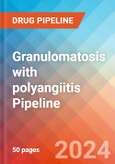Granulomatosis with polyangiitis Understanding
Granulomatosis with polyangiitis: Overview
Granulomatosis with polyangiitis formerly known as Wegener's granulomatosis is an uncommon disorder that causes inflammation of the blood vessels in your nose, sinuses, throat, lungs and kidneys. It is classified as an autoimmune disorder. It is the result of inflammation within the tissues called granulomatous inflammation and blood vessel inflammation ('vasculitis'), which can damage organ systems. The area’s most commonly affected by GPA include the sinuses, lungs, and kidneys, but any site can be affected. Granulomatosis with Polyangiitis is nearly equally distributed between the sexes, with a slight male predominance. Granulomatosis with Polyangiitis typically occurs in middle age, but is found in people of all ages.Symptoms
- Loss of appetite
- Weight loss
- Fever
- Fatigue
- Nasal or facial pain
- Nose bleeds or unusual nasal discharge, caused by inflammation of the nose or sinuses
- Chest discomfort with or without shortness of breath
- Joint pain
- Rashes or skin sores
Diagnosis
A diagnosis of granulomatosis with polyangiitis is made based upon a thorough clinical evaluation including routine laboratory tests, a detailed patient history, identification of relevant symptoms, and a variety of specialized tests. One way in the diagnosis of Granulomatosis with Polyangiitis is by biopsying an involved organ and finding the pathologic features of this disease under the microscope. Chest X-rays, CT or MRI can help determine which blood vessels and organs are affected.Blood tests can check for: Signs of inflammation, Anti-neutrophil cytoplasmic antibodies and anemia.Treatment
Treatment generally involves taking prescription drugs long term to prevent relapse.With early diagnosis and appropriate treatment, it becomes easy to recover from granulomatosis with polyangiitis within a few months. Corticosteroids such as prednisone help suppress the immune system and reduce inflammation of the blood vessels. Rituximab (Rituxan) is another option for treating granulomatosis with polyangiitis. In cases of very serious granulomatosis with polyangiitis, plasmapheresis can help the kidneys recover.Granulomatosis with polyangiitis Emerging Drugs Chapters
This segment of the Granulomatosis with polyangiitis report encloses its detailed analysis of various drugs in different stages of clinical development, including phase II, I, preclinical and Discovery. It also helps to understand clinical trial details, expressive pharmacological action, agreements and collaborations, and the latest news and press releases.Granulomatosis with polyangiitis Emerging Drugs
- Abatacept: University of South Florida
- IFX-1 (Vilobilemab):InflaRx GmbH
Granulomatosis with polyangiitis: Therapeutic Assessment
This segment of the report provides insights about the different Granulomatosis with polyangiitis drugs segregated based on following parameters that define the scope of the report, such as:Major Players in Granulomatosis with polyangiitis
There are approx. 10+ key companies which are developing the therapies for Granulomatosis with polyangiitis. The companies which have their Granulomatosis with polyangiitis drug candidates in the mid to advanced stage, i.e. phase III and Phase II include, InflaRx GmbH and others.Phases
The report covers around 10+ products under different phases of clinical development like
- Mid-stage products (Phase II and Phase I/II)
- Early-stage products (Phase I/II and Phase I) along with the details of
- Pre-clinical and Discovery stage candidates
- Discontinued & Inactive candidates
Route of Administration
Granulomatosis with polyangiitis pipeline report provides the therapeutic assessment of the pipeline drugs by the Route of Administration. Products have been categorized under various ROAs such as- Subcutaneous
- Intravenous
- Intramuscular
Molecule Type
Products have been categorized under various Molecule types such as
- Small molecules
- Natural metabolites
- Monoclonal antibodies
Product Type
Drugs have been categorized under various product types like Mono, Combination and Mono/Combination.Granulomatosis with polyangiitis: Pipeline Development Activities
The report provides insights into different therapeutic candidates in phase II, I, preclinical and discovery stage. It also analyses Granulomatosis with polyangiitis therapeutic drugs key players involved in developing key drugs.Pipeline Development Activities
The report covers the detailed information of collaborations, acquisition and merger, licensing along with a thorough therapeutic assessment of emerging Granulomatosis with polyangiitis drugs.Report Highlights
The companies and academics are working to assess challenges and seek opportunities that could influence Granulomatosis with polyangiitis R&D. The therapies under development are focused on novel approaches to treat/improve Granulomatosis with polyangiitis.Granulomatosis with polyangiitis Report Insights
- Granulomatosis with polyangiitis Pipeline Analysis
- Therapeutic Assessment
- Unmet Needs
- Impact of Drugs
Granulomatosis with polyangiitis Report Assessment
- Pipeline Product Profiles
- Therapeutic Assessment
- Pipeline Assessment
- Inactive drugs assessment
- Unmet Needs
Key Questions
Current Treatment Scenario and Emerging Therapies:
- How many companies are developing Granulomatosis with polyangiitis drugs?
- How many Granulomatosis with polyangiitis drugs are developed by each company?
- How many emerging drugs are in mid-stage, and late-stage of development for the treatment of Granulomatosis with polyangiitis?
- What are the key collaborations (Industry-Industry, Industry-Academia), Mergers and acquisitions, licensing activities related to the Granulomatosis with polyangiitis therapeutics?
- What are the recent trends, drug types and novel technologies developed to overcome the limitation of existing therapies?
- What are the clinical studies going on for Granulomatosis with polyangiitis and their status?
- What are the key designations that have been granted to the emerging drugs?
Key Players
- InflaRx GmbH
- Bristol-Myers Squibb
- Hoffmann-La Roche
- Iqvia Pty Ltd
Key Products
- Abatacept
- IFX-1
This product will be delivered within 2 business days.
Table of Contents
Companies Mentioned (Partial List)
A selection of companies mentioned in this report includes, but is not limited to:
- InflaRx GmbH
- Bristol-Myers Squibb
- Hoffmann-La Roche
- Iqvia Pty Ltd








